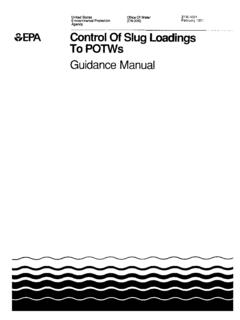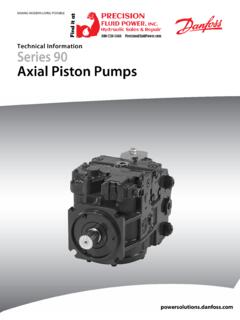Transcription of The Cooling Water Handbook - Buckman
1 The Cooling Water HandbookA basic guide to understanding industrial Cooling Water systems and their treatment23 Cooling Water an introduction .. 5 Types of Cooling systems .. 7 Once-through .. 7 Open recirculating .. 7 Closed recirculating .. 8 Specialized .. 8 Common Cooling Water issues .. 9 Scale .. 9 Corrosion .. 9 Organic fouling .. 10 Microbiological deposits .. 10 Foam .. 10 Basic Cooling Water treatment .. 11 Audit and assessment .. 11 Cooling Water pretreatment .. 11 Chemical applications .. 12 Fighting scale .. 12 Fighting corrosion .. 12 Fighting microbiological fouling.
2 13 Fighting foam .. 14 Monitoring .. 15 Conclusion taking the heat off your operating budget .. 17 Learn more .. 19 Contents4| Open Recirculating System| Closed Recirculating System| Once-Through SystemHeat ExchangerPumpColdHotHeat ExchangerPumpIntakeDischargeEvaporationB lowdownHeat ExchangerPumpCooling TowerMakeupWater5 Water is used around the world in industrial applications because it has a number of valuable properties . It s non-toxic . It s readily available in many parts of the world . Its flow can be controlled easily through pressure or gravity . And, perhaps most important for Cooling Water systems, it provides a high level of thermal conductivity, the ability to absorb heat and transport it away.
3 When we use Water to lower the operating temperature of equipment or entire plants, it is called Cooling Water . Industries such as power, pulp and paper, oil and gas, ethanol, steel, mining, leather and manufacturing operations of every description depend on Water for Cooling . Water is extremely good at dissolving substances and distributing them through-out itself . That s good when you want to deliberately dilute and mix chemicals . It s not so good when unwanted impurities are dissolved . Surface waters used to supply Cooling systems are open to the greater environ ment and can contain a wide variety of organic suspended matter that causes microbiological fouling.
4 Ground Water , while protected from some of the contaminants surface waters face, can contain high amounts of corrosion-causing metals, such as manganese and iron .When unwanted compounds build to the point that solubility is no longer possible, scale forms . When algae and bacteria enter the system, Water temperatures and nutrients can quickly aid in their growth, reducing Water quality, fouling system surfaces and promoting corrosion . | Water works for us| And against usAn Introduction to Cooling Water6 Because Water is so good at dispersing minerals and helping living things grow, Water in Cooling systems must be specially treated and monitored.
5 The goal is Water that runs free and clean, maximizing its ability to absorb heat and carry it away, so your systems stay cool . The key is Water treatment optimization the ability to not only apply the right chemistries but also to constantly monitor and control Water quality to keep it balanced at all times . By monitoring pH, Water temperature, electrical conductivity, microbiological activity, corrosion, chemistry levels and other variables, your plant can be proactive . That not only helps keep contaminants from growing in your system but also helps you grow the bottom line . The right program can: Increase production Reduce downtime Lower operating and chemical costs Reduce your operation s impact on the planet| That s why proper treatment is important7 Treatment of Cooling Water will be different depending upon the kind of system in use.
6 Here are the basic types:A once-through Cooling system pumps Water into equipment where it passes over a hot surface in order to cool it . The Water then exits the equipment, taking heat with it . Simple and effective in a wide range of applications, this system can be undermined by the quality of the raw Water . Lakes and rivers can bring in suspended matter and pollutants . Well waters can contribute large amounts of iron and scale-forming materials . Because Water is only used once, a large amount of Water is required .| Once-throughThis system sends Cooling Water out of the equipment and into a pond or Cooling tower, which is open to the atmosphere.
7 Here evaporation occurs, removing heat along with the evaporated Water . As a result, the remaining Water cools . It is then combined with makeup Water , which replaces the evaporated Water , and is sent through the system again . Open-recirculating systems have become prevalent as Water has become scarcer and environmental restrictions have been placed on bleedoff discharge .| Open recirculatingTypes of Cooling Systems8 All Water used to carry heat away from equipment is run through a heat exchanger, which is cooled by air, mechanical refrigeration or a separate open Cooling Water system . There is no evaporation or makeup Water required, so contamination and the maintenance that results is less likely.
8 Since the same Water is used over and over, Water and sewage costs are lower and environmental compliance is easier . Many once-through systems have been converted to closed systems for this reason .| Closed recirculatingA specialized Cooling system might utilize compression or absorption-type refrigeration or air conditioning systems, which can be used to cool both processes and work spaces . It might utilize a Cooling coil below the deck of the Cooling tower . Or it might include the use of industrial air washers in which air is filtered, sprayed and then forced through a series of mist eliminators . Each system has its own unique risks for fouling and must be treated accordingly.
9 | SpecializedScale9 Common Cooling Water issuesCooling Water has many enemies. Sometimes they work alone. In other instances, they team up and compound the problem. For example, algae growth creates the perfect environment for corrosion to take hold. Here s a quick look at the major sources of Cooling Water and scalelike deposits include calcium carbonate, calcium phosphate, magnesium silicate, silica and other mineral compounds . They build up on heat exchanger tubes, reducing heat transfer . In sufficient amounts they can restrict Water flow . When heat transfer is reduced, efficiency of production is reduced and the quality of products can be compromised.
10 Equipment can suffer damage from overheating . Scale can cause expensive downtime for cleaning or repair, resulting in lost revenue . In addition, scale and scalelike deposits can accelerate corrosion .| ScaleCorrosion occurs when electrically charged particles flow through metal components, causing the metal to oxidize and eventually lose thickness . Corrosion causes pitting and leaks in Cooling systems and can lead to the replacement of pipes, pumps, heat exchanger tubes and even entire Cooling towers . Iron oxide, especially, contributes to fouling and deposition, which interfere with heat transfer . Downtime for equipment repair or replacement is always costly.

